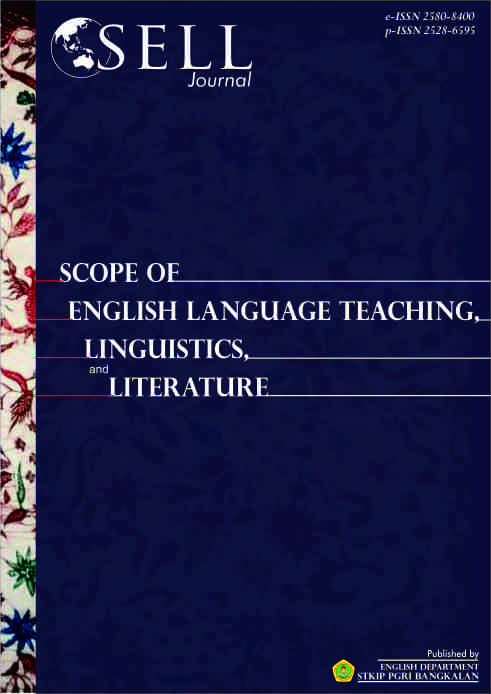AN ANALYSIS OF SENTENCE FRAGMENT FOUND IN STUDENTS WRITING PARAGRAPH
DOI:
https://doi.org/10.31597/sl.v7i2.803Keywords:
fragment, writing, errorAbstract
Study writing become a challenge one, because their need as student strive to be produce a good paragraph but the reality sometimes they make an error in their paragraph. One of the error is fragment. Fragment is incomplete sentence. This research is aimed to identify some fragment in student’s writing paragraph and what is source of the error that occurred in students’ writing. It is descriptive qualitative. The participant data in this research is taken from 25 students. The researcher used class X A in senior high school Wachid Hasyim year 2021/2022 as sample. The result of this study showed the most common fragment found in their subject and complete verb are omitted is the highest , the second position is a dependent clause fragment is the second, the third rank is the verb is omitted and the last position is the subject is omitted with. Moreover the questionnaire showed that the incomplete knowledge of English is the source of student’s errors.
References
Ariyanti, A., & Fitriana, R. (2017) EFL Students’ Difficulties and Needs in Essay Writing
Bashir , I . Yusof, N.B., Sadiq, N.A., Nor, S., Omar, S., & Bashir, I. (2016) Scholars Journal of Arts, Humanities and social sciences Sentence Fragmentation in the Writing of Senior Seconday School Students of
Connelly, M.(2013) A rhetoric, reader, and research guide (5thed.). USA: Wordsworth Language Learning Press.
Crystal, D. (2008). A Dictionary of Linguistics and Phonetics. 6th Edition. Oxford: Blackwell Publishing
Fine CB; The student writer: Editor and Critic, (8th Ed.). New York: The McGraw-hill Companies, Inc., 2010.
Harmer, J. (2004). How to Teach Writing. Harlow: Longman.
Imane, B. (2016) The Effect of Unexplained Grammatical Errors on Students’ Writing Performance Case Study
Jean W; Steps to writing Well. USA, 2002.
Medwell; Primary English: Knowledge and understanding (2nded.). London:Sage Publications Ltd., 2006.
Oshima, A., & Hogue, A.(1998). Writing Academic English, third edition. Young Publishing House
Phuket, P.R.N. (2015). Understanding EFL Students’ Error in Writing. Journal of Education and Practice, Vol.6, No32 p 99
Schuster , E.H (2006) A Fresh Look at Sentence Fragments. English Journal, Vol 95. No.5
Sugiyono. (2016). Metode Penelitian Kuantitatif, Kualitatif dan R&D. Bandung: PT Alfabet.
Swan, M (2001). Learner English. Cambridge: Cambridge University Press.
Yi, J-Y (2009) Defining Writing Ability for Classroom Writing Assessment In High Schools. Pan-Pacific Association Of Applied Linguistics, 13 (1), 53-69
Downloads
Published
How to Cite
Issue
Section
License
1. Copyright of this journal is possession of Editorial Board and Journal Manager, by the knowledge of author, whilst the moral right of the publication belongs to the author.
2. Legal formal aspect of journal publication accessibility refers to Creative Commons Atribution-ShareAlike (CC BY-SA), implies that this license lets others remix, adapt, and build upon your work even for commercial purposes, as long as they credit you and license their new creations under the identical terms. This license is often compared to “copyleft” free and open source software licenses.
3. Every publications (printed/electronic) are open access for educational purposes, research, and library. Other that the aims mentioned above, editorial board is not responsible for copyright violation















